Native
Exotic, but established
Exotic
Epinotia Hübner (Tortricidae: Olethreutinae: Eucosmini)
Epinotia is a large genus composed of 187 described species (Brown & Brown 2018), about 80 of which occur in the Nearctic region (Powell & Opler 2009). The Holarctic region has a similar level of diversity; a few species are known from the Neotropical, Indomalayan, and Madagascan regions.
Host plants are known for many of many species and most species are assumed to be host specific (Brown & Brown 2018), with records from a wide range of plant families, including both conifers and angiosperms. Larvae are leaf-tiers, catkin borers, or needle miners (Gilligan et al. 2008Gilligan et al. 2008:
Gilligan, T. M., Wright, D. J., Gibson, L. D. 2008. Olethreutine moths of the midwestern United States, an identification guide. Ohio Biological Survey, Columbus, Ohio. 334 pp.). Most species of Epinotia are univoltine, often either flying in the early spring or late fall, depending on species.
An unpublished Ph.D. thesis by Richard L. Brown (1980)Brown (1980):
Brown, R. L. 1980. A revision of the genus Epinotia Huuml;bner (Tortricidae: Eucosmini), part 1. The North American species of the stroemiana lineage. Ph.D. thesis, Cornell University, Ithaca, New York. is the most thorough revision of the genus. The most relevant treatment of the North American fauna is that of Brown (1987b), which included members of the difficult Epinotia vertumnana species group.
Many species of Epinotia display significant intraspecific differences in forewing color and maculationmaculation:
markings, pattern of spots, bands, blotches, streaks, etc. 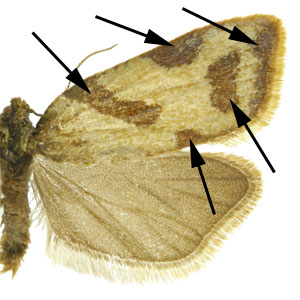 , making examination of the genitalia necessary for some species. Even then, differences in genitalia are often subtle. Males may or may not possess a forewing costal foldforewing costal fold:
, making examination of the genitalia necessary for some species. Even then, differences in genitalia are often subtle. Males may or may not possess a forewing costal foldforewing costal fold:
a flap or fold at the base of the forewing that contains specialized sex scales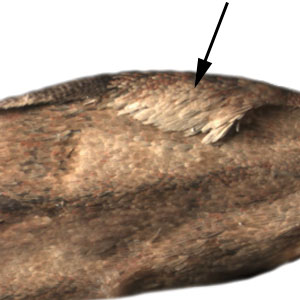 . Male genitalia are typically characterized by a well-developed, bifidbifid:
. Male genitalia are typically characterized by a well-developed, bifidbifid:
cleft, forked, divided into two parts 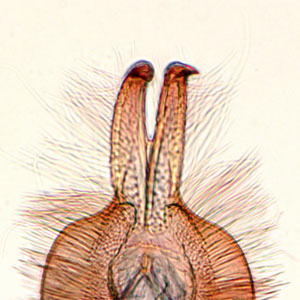 uncus; sociisocii:
uncus; sociisocii:
a pair of lightly sclerotized setose lobes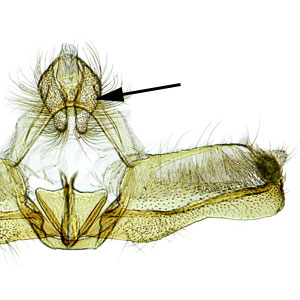 and valvaevalvae:
and valvaevalvae:
plural of "valva" variously shaped. Female genitalia are characterized by a variably shaped sterigmasterigma:
variously shaped. Female genitalia are characterized by a variably shaped sterigmasterigma:
the sclerotized region surrounding the female ostium bursae 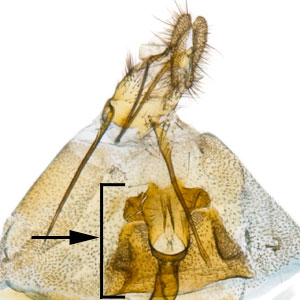 ; two horn- or thorn-like signasigna:
; two horn- or thorn-like signasigna:
plural of "signum"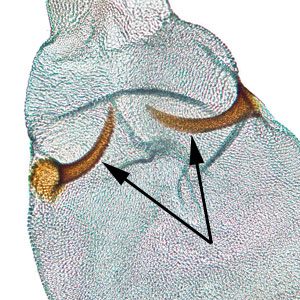 in the corpus bursaecorpus bursae:
in the corpus bursaecorpus bursae:
a dilated membranous sac at the anterior end of the bursa copulatrix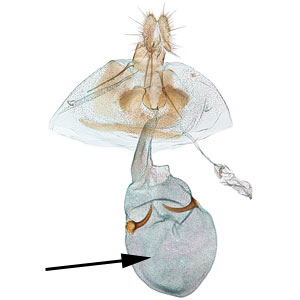 ; and minute spinules on the inner surface of the corpus bursaecorpus bursae:
; and minute spinules on the inner surface of the corpus bursaecorpus bursae:
a dilated membranous sac at the anterior end of the bursa copulatrix .
.
No North American species of Epinotia are considered to be significant pests, although the introduced European E. nanana can be a pest on ornamental spruce. We include this genus on this site because of the high number of species that occur in North America.
View full screen host table here